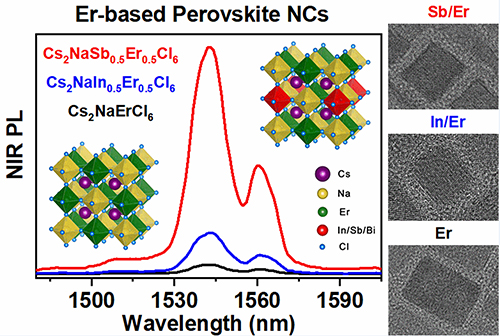Scientists Design Lead-free Rare-earth-based Double Perovskite Nanocrystals with Near-infrared Emission
Lead-free halide perovskite nanocrystals (NCs) with unique optical properties are promising in light-emitting diodes (LEDs), photodetectors, and solar cells.
Previous studies mainly focused on the photoluminescence (PL) in the visible region, and those on the near-infrared (NIR) PL of lead-free perovskite NCs are rare.
Recently, a research group led by Prof. HAN Keli from the Dalian Institute of Chemical Physics (DICP) of the Chinese Academy of Sciences (CAS), in collaboration with Prof. MIAO Xiangyang's group from Shanxi Normal University, designed colloidal synthesis of all-inorganic rare-earth-based double perovskite NCs with NIR emission, and revealed their exciton dynamics.
This study was published in Laser & Photonics Reviews on August 27.

NIR PL emission spectra and HRTEM images of Cs2NaEr0.5B0.5Cl6 NCs (Image by HAN Peigeng and WU Ruixiang)
The researchers synthesized all-inorganic rare-earth-based Cs2NaEr1-xBxCl6 (B: In, Sb, Bi; x = 0, 0.13, 0.5) double perovskite NCs by hot injection with variable temperature.
They found that all these NCs exhibited a NIR PL emission from 4I13/2 → 4I15/2 transition of Er3+, and on account of the incorporated Sb3+, Cs2NaEr0.5Sb0.5Cl6 NCs showed a 23-fold NIR PL enhancement with the average lifetime of 119.1 μs.
"The origin of NIR PL enhancement was attributed to the increase of exciton absorption, the longer PL lifetime, the suitable phonon-assisted process caused by the indirect band structure, and the process of long-lived dark trap state assisted NIR PL emission," said Prof. HAN.
This work was supported by the National Key Research and Development Program of China, the National Natural Science Foundation of China, and the Scientific Instrument Developing Project of CAS. (Text by HAN Peigeng and WU Ruixiang)